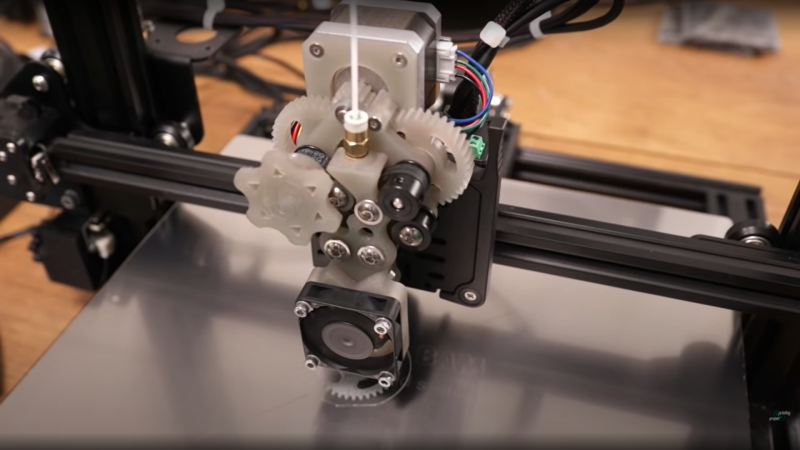
[Proper Printing] clearly enjoys pushing the boundaries of 3D printed materials, and sometimes this requires building custom 3D printers or at least the business end of them. Flexible filaments can be a bit of a pain to deal with, simply because most extruders are designed to push the filament into the hot end with a simple hobbed bolt (or pinch roller setup) and only work reliably due the rigidity of the plastic itself. Once you go flexible, the rigidity is reduced and the filament often deflects sideways and the extruder jams. The longer the filament path leading to the hotend, the harder it gets. The dual belt drive extruder (they’re calling it ‘proper extruder’) grips the filament on two sides with a pair of supported belts, guiding it into the hotend without allowing it to deflect sideways. The extruder body and gears were resin printed (but, we checked — the design is suitable for FDM printing as well) proving that resin printing on modern printers, does indeed maintain adequate dimensional accuracy allowing the building of mechanisms, despite the naysayers!
The extruder design took a bit of tweaking, as the belts themselves, were deflecting, but after a few iterations to add some guide rails, it appears to work rather well. Of course we usually don’t get to see all the failures along the way! That withstanding, they started by testing flexible filaments in a logical manner, starting with a minimally flexible filament, with a shore hardness of 93A, before quickly moving onto NinjaFlex (85A hardness) and even successfully printing a gear in an unidentified 60A hardness filament.
The test printer was a Creality CR-10, with a WhamBam Mutant tool-changer installed, so an adaptor plate was needed for this to allow the ‘proper extruder’ to be mounted. The belt-driven design, with the extra friction from the modifications proved a little too much for the typical NEMA17 stepper motor used for direct drive extruders, so they needed to use a beefier unit. Due to the heat from the this larger motor, it needed to be printed in polycarbonate (we think, the video is unclear) to prevent warpage during operation, but that shouldn’t be a major obstacle for the intrepid builder wanting to duplicate this work, we reckon.
We’re no strangers to 3D printing with flexible materials, and the associated hacks to tame them, such as this modified bowden driver for TPU. The applications for printing with flex are numerous and important, such as printing custom gaskets, to name but one, so anything that lowers the difficulty of printing with the floppy stuff is a great step in the right direction in our eyes.
Thanks [BaldPower] for the tip!
Tame Your Flexible Filaments With This Belt-Drive Extruder
Source: Manila Flash Report
0 Comments